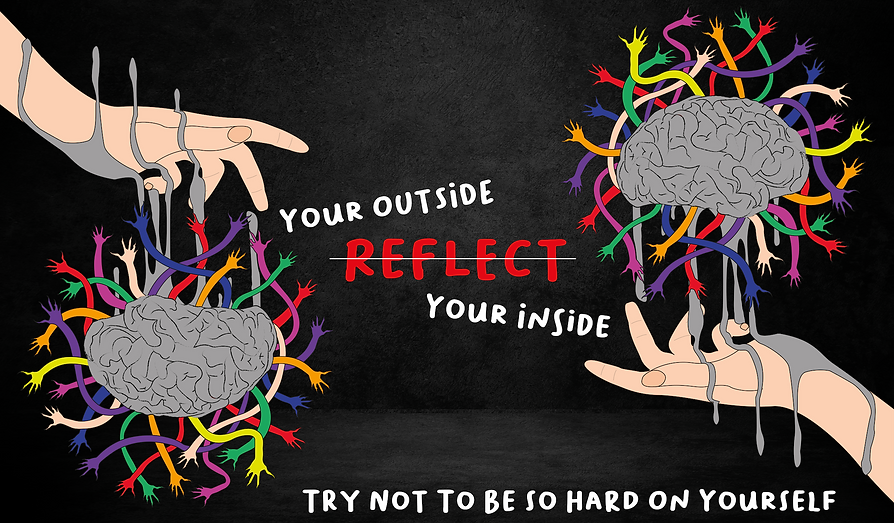1st Statement Of Intent
Mental illnesses have always been an issue that bothers and affects a person’s mind. However, a designer has an incredible capacity to elevate language to express goals that helps in their mental well-being. Design is about combining the chaos, neats and creating visuals that help prove where one’s creativity stands. Designing should also be an implementation that helps to enlighten an individual or world. Therefore, a designer’s vision and mission are to let off emotions or feelings through their art and design.
Designers can persuade individuals by artful works and designs; it is also necessary to understand how design shows an impact in art therapy. Art therapy is being used as a way of treating mental patients because it helps the individual to recognise and acknowledge feelings that exist in the individual’s subconscious. Through a comprehensive approach, art therapy captivates the mind, body, and spirit which could benefit a sufferer’s thinking, feelings, acts, and behavior.
Art therapy improves the mental health of the people who are dealing with mental problems. Involving in creating art and designs, the colours used in designs can help enlighten the mood of the sufferers. Hence, with the help of design and art therapies, designers are able to help in improving an individual’s mental health.
Annotated Bibliography
1. Ben Longden. (2020). Graphic Design Is Mental.
-
This is a book about creativity and mental health. It explores imposter syndrome, how you can feel when starting out as a designer, and some of the challenges that might be faced along working in the creative industry.
2. Deborah Malcolm. (2015). Meh.
-
Meh is a wordless picture book about one boy's journey through depression. Discussion questions at the back of the book are intended for parents or teachers to discuss depression with children.
3. Dontay Farley Sr. (2007). Happy. Retrieved from: https://digitalcommons.georgiasouthern.edu/cgi/viewcontent.cgi?article=2840&context=etd
-
This thesis is an exploration of graphic design and how it can be used as a tool to create awareness about mental illness and positive solutions to decrease its effect on individuals. Using the “simple things'' in life as metaphors, this thesis attempts to use graphic design as a way to help decrease mental illness.
4. Lesley Lubos. (2012). The Role of Colors in Stress Reduction. Retrieved from: https://www.researchgate.net/publication/314578015_The_Role_of_Colors_in_Stress_Reduction
-
The study was conducted to determine the effect of colors on stress reduction. There was a significant reduction in the students' level of stress after exposure to blue and pink color therapy.Those students with color therapy had a higher reduction of stress level than those who did not receive the therapy.
5. Toby Allen. (2015). Artist Suffering From Anxiety Draws Mental Illnesses As Real Monsters. Retrieved from: https://www.youtube.com/watch?v=P9YD0U8QEuM
-
This video is about a UK based artist Toby Allen using his artwork to shed light on mental illnesses in hopes of making them more manageable. He wants people to be aware of how damaging illnesses are and how much of a burden they can be to those who suffer from them.
6. FunnyPig. (2019). Illustrations About Mental Illness And Their Accurate Depictions Says It All. Retrieved from: https://www.youtube.com/watch?v=o4pFEIe_uEw
-
This video is about a UK-based artist from NeverStayDead that makes comics and illustrations about what it is like inside the mind of people suffering from different disorders by using art depicting mental illness.
7. Roberto Blake. (2014). Graphic Design: Dealing with Depression as a Graphic Designer. Retrieved from: https://www.youtube.com/watch?v=rV1j5f1VNKI
-
Some advice was given in this video by Roberto Blake on how to deal with depression as a Graphic Designer. Many graphic designers and other creative professionals often find themselves struggling with depression or anxiety. It is a serious issue in the design industry affecting people at every age and every stage of their careers.
8. Ruby Boddington. (2017). GraphicDesign& outline three projects that successfully support and impact mental wellbeing. Retrieved from: https://www.itsnicethat.com/articles/graphicdesign-and-graphic-design-world-mental-health-day-101017
-
This article examines the varied and vital relationship between graphic design and health, believing that designers and visual languages have much to contribute to the area of mental health, where imagination and ingenuity can transform the communication, diagnosis, awareness and support.
9. Carolyn Mehlomakulu. (2012). Colour Symbolism In Art Therapy. Retrieved from: https://creativityintherapy.com/2012/08/color-symbolism-in-art-therapy/
-
This article talks about the importance of understanding the symbolism of colours in art therapy. Colours can communicate a meaning just as importantly as images and words. It is important to know why their clients choose a specific colour depending on their thinking or feeling.
10. Sean Clarke. (2020). How Color Affects Your Mood and Mental Health. Retrieved from: https://medium.com/change-becomes-you/how-color-affects-your-mood-and-mental-health-76fff36853c
-
This web article is about how color affects your mood and mental health. Everyone interprets colour differently, identifying how colours make them feel personally important. Colours are used to enhance a person’s mood as well as knowing what they think of and feel about the colours.
Followed by the statement of intent, the flag is designed to represent my intent as a designer. The intention of the designer is supported with 10 annotated bibliographies for the following outcome.


